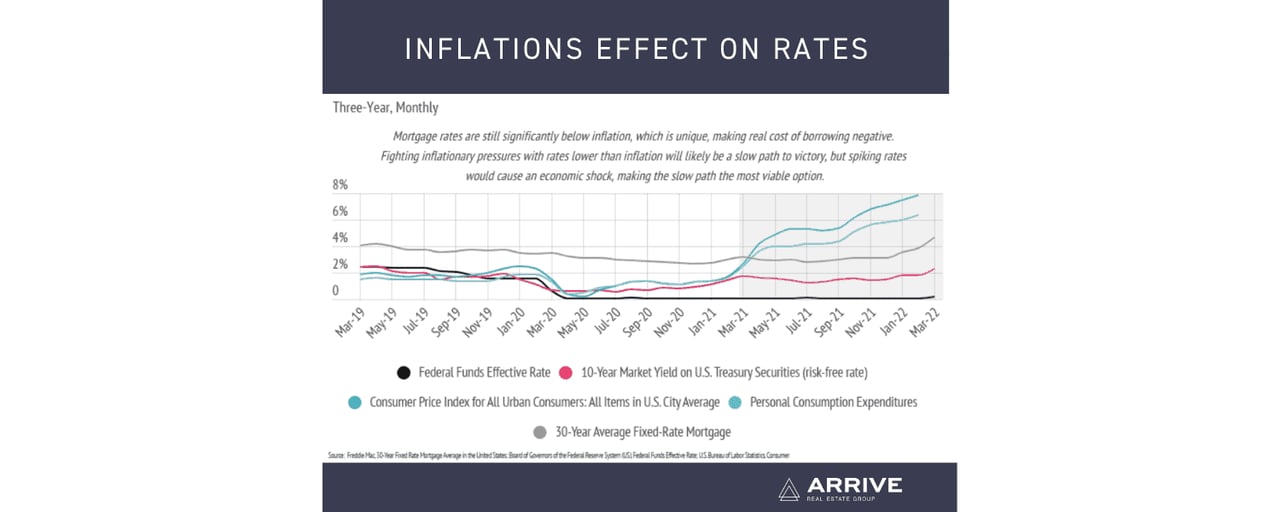Welcome to our April newsletter, where we’ll explore residential real estate trends in the East Bay and across the nation. As your local real estate experts, we feel it’s our duty to give you, our valued client, all the information you need to better understand our local real estate market. Whether you’re buying or selling, we want to make sure you have the best, most pertinent information, we’re here to support you.
Early Innings For Rising Rates
Will rising interest rates normalize the housing market? Mortgage rates rose faster than expected in the first quarter of 2022, already surpassing forecasts for the year. The 30-year average mortgage rate rose swiftly in the two weeks after the Fed’s March meeting, up 0.5% between March 17 and 31 to 4.67%. This rapid increase has spurred purchases as buyers try to lock in lower rates before they climb higher. Home prices in the United States hit a record high. Historically low inventory, coupled with an urgency around rising interest rates, incentivized homebuyers to buy sooner rather than later.
Inflation is driving the Federal Reserve’s (the Fed’s) monetary policy. The Fed indicated at least six more 0.25% federal funds rate increases this year, so as to reach the consensus-estimated federal funds rate of 1.9% by year’s end. Due to this, mortgage rates increased in anticipation and are likely to be affected less when the Fed moves the federal funds rate in the future, if it sticks to its schedule. At this point, we can almost guarantee that rates will not decline substantially this year.
In addition to rising rates, supply still drives home prices. From March 2020 to March 2022, the housing supply declined 62%. Over the past three months, which had the lowest inventory on record, home prices increased nearly 10%. Rising rates, in the short term, boost demand because potential homebuyers want to get ahead of the increase, but in the long term, they reduce demand. Because the market is so undersupplied, less demand is actually a good thing. Home prices simply cannot maintain the rapid increases. Although a housing bubble isn’t likely yet, a sustainable growth rate is better and safer for the long term.
The Local Lowdown
Home prices close the first quarter at record highs. Single-family home prices rose significantly over the last two months, reaching all-time highs for single-family homes for Alameda County, while Contra Costa prices landed just below peak. Because sales often have a one-month lag, with homes going under contract around a month before the sale is complete, we cannot yet determine how significantly increasing rates have hit the market. Mortgage rate hikes really only lower demand in the long term, but in the short term, demand increases as buyers try to lock in a lower rate. The East Bay housing market has a major advantage in that high demand is constant.
The East Bay, like the rest of the country, has a historically low housing inventory. The sustained high demand and lack of new listings over the past year brought single-family home supplies to record lows across markets. Although the first quarter of 2022 had the lowest inventory on record, we are pleased to see that inventory is increasing. If this upward trend continues into the second quarter, that will be a large indicator that the housing market is normalizing. The incredibly high demand we’ve seen over the past year might wane as interest rates increase.
As always,
Arrive Real Estate Group remains committed to helping our clients achieve their current and future real estate goals. Our team of experienced professionals are happy to discuss the information we’ve shared in this newsletter. We welcome you to
contact us with any questions about the current market or to request an evaluation of your home.

